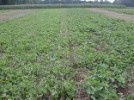July 6, 2010

Extended periods of rainfall, flooding, hail, or all of the above have some farmers scrambling for replant or prevented planting options. Each choice has practical and economic implications, so should be approached with some thought, says Steve Barnhart, Iowa State University Extension forage agronomist.
One consideration is the implication for crop insurance. Before changing crops or planting an 'emergency' forage crop, check with your crop insurance representative. Barnhart also offers other suggestions and information.

When considering crops for an annual forage, he points out that the practical issues include: Can I use, sell or rent the forage? Will the forage crop be harvested as silage or dry hay? Will it be grazed or simply be a 'cover crop'? While many species may fit the criteria for these uses, the following are among the most practical, predictable and economical.
Look at the various options you have available in your situation
* Dry hay options: Foxtail millet, Japanese millet, Sudangrass (maybe), Teff, Oats
* Silage options: Foxtail millet, Japanese millet, Sudangrass, Sorghum X Sudan Hyb, Hybrid pearl millet, Teff, Oats
* Grazing options: Foxtail millet, Japanese millet, Sudangrass, Sorghum X Sudan Hybrid, Hybrid pearl millet, Teff, Oats
Seed supplies of some of these forage crops are in short supply in normal production years. As you consider these as options for your needs, check on seed availability.
* Sudangrass can be a multiple-cut, summer annual, for use as fresh cut forage, pasture or silage. It should be rotationally grazed for best use, and can be difficult to dry thoroughly for hay. Varieties vary in height and leafiness. Sudangrass can be planted through early July, with the first growth useable in about 50 days. At this late planting date you may get a second harvest or grazing. A hydrocyanic acid poisoning (Prussic acid) risk is minimal, but avoid pasturing severely drought stressed or very short (less than12 inches) growth/tiller regrowth and use caution if grazing soon after frost.
* Hybrid Sorghum X Sudangrass is a multiple-cut, summer annual; used for fresh cut forage, pasture (rotation grazing is recommended) or silage. Varieties vary greatly in height, leafiness, and grain yield depending on the parent lines making up the hybrid. These hybrids can be planted through early July, with the first growth useable in about 50 days. At this late-planting date you may get a second harvest or grazing. There is a hydrocyanic acid poisoning (Prussic acid) risk if plants or tillers are grazed or green fed at short height (shorter than 24 inches) or during severe drought, and use caution if grazing soon after frost.
* Sudangrass, and sorghum X sudangrass hybrids are better adapted than most species to drought, high temperature, and low soil pH than corn, but will yield less in seasons with cool August and September temperatures. Sudangrass and sorghum X sudangrass hybrids should be harvested at 2 to 3 feet of height (two to three cuttings for season). Harvesting at later maturity may increase yield but will result in very low forage quality.
* Short grain sorghum / forage soybean mixture planted through early summer. Harvestable within about 60 days. Requires good fertilization for production. Harvest at late vegetative or very-early head stage of the sorghum.
* Foxtail Millet is a warm season, annual grass also called German, Siberian, or hay millet. Foxtail millet can be used as harvested or grazed forage. It can be planted through early July and is useable in about 50 days. Only one summer growth should be expected. Foxtail millet is best of the 'millets' for an emergency hay crop, but can become a weedy grass if allowed to produce mature seed.
* Japanese Millet is a summer annual grass and produces relatively coarse (stemmy) forage. It can be used as fresh cut forage, hay, silage or pasture. It can be planted through early July and is useable in about 50 days. If first crop is cut at vegetative growth stage, regrowth yields are more likely. Japanese millet is closely related to the grassy weed barnyard grass, so avoid allowing seed formation.
* Hybrid Pearl Millet is a multiple-cut, warm-season annual, used for fresh cut forage, pasture (rotation grazing is recommended), or silage. It resembles sorghum X sudangrass hybrids in plant structure and can be planted through early July and is useable in about 50 days. It has somewhat slower regrowth than sorghum X sudangrass hybrids, and has limited production in cool summer seasons. No risk of hydrocyanic acid (Prussic acid) poisoning with pearl millet.
These annual millets have been of interest in recent years. Remember these are warm-season crops and perform best in warm, sunny growing seasons. They have not performed up to expectation during cool, cloudy summers.
* Teff is an annual forage grass that has been grown by a few growers in Iowa and is a warm-season grass. It can be planted from mid-May into July. Its seeds are very small and must be planted very shallowly. Teff seedlings are relatively non-competitive, but once established, can produce one or more harvests of grass hay. Grazing should be delayed until later in the summer, when root systems are stronger. As with other annual forage crops, later planting dates limit the yield potential.
* Oats can be planted in July as a cover crop and grazed about any time. It may produce seed heads at a short height. It can be cut and stored as dry hay or silage from late-vegetative through early milk stage. At dough stage, the stems decrease feeding value greatly. Other cereal grains may also fit this use, such as barley, spring wheat, or spring triticale, but their seed will likely be more expensive and in shorter supply than for oats.
While it's the farthest thing from our minds now, these annual forages can come under scrutiny later in the growing season for high nitrate risk if season turns dry.
You May Also Like




